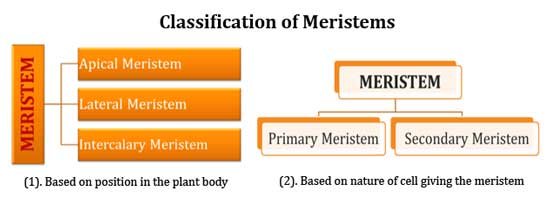What is Meristem?
Meristem is a type plant tissue composed of an undifferentiated mass of cells. They are rapidly dividing cells found in the growing portions of the plant and they give rise various plant organs. The primary function of meristem is to assist in plant growth. Living cells other than meristem can also give rise new cells; however, the meristems carry on such activity indefinitely. The present article discusses the Classification of Meristematic Tissue with examples.
Ø Meristematic cells not only add new cells to the plant body but also perpetuate themselves.
Ø Meristematic cells when divide, some portions of division do not differentiate into adult cells but remain meristematic.
Ø The term meristem was first proposed by Karl Wilhelm von Nägeli (1817–1891) in his book Beiträge zur Wissenschaftlichen Botanik (“Contributions to Scientific Botany”).
Ø The word meristem is derived from a Greek word ‘merizein’ meaning ‘to divide’.
Characteristics of Meristematic Tissue
Ø The characteristic features of meristematic cells are summarized in the post: Characteristic Features of Meristematic Cells
Classification of Meristematic Tissue
Ø Meristems are classified according to TWO criterions
(1). Classification based on position in the plant body
§ Apical meristem
§ Lateral meristem
§ Intercalary meristem
(2). Classification based on nature of cell giving the meristem
§ Primary meristem
§ Secondary meristem

Classification of meristems based on position in the plant body
(1). Apical Meristem
Ø Apical meristems occur at the growing tips of plant parts such as the tip of stem, roots and leaves.
Ø They are also called as APICAL CELL or apical initial.
Ø Apical meristem may constitute of one or more cells.
Ø The number of apical cells in the apical meristem varies in different plant groups.
Ø Lower plants (Bryophytes and Pteridophytes) usually have a single apical cell.
Ø In Gymnosperms and Angiosperms, the apical meristem composed of a group of cells.
Ø Cells in the apical meristem always maintain their individuality and position.
Ø The activity of apical meristem causes increase in the length of shoot, root and leaves.
Ø Apical meristem produces the primary structure of plants.
Ø Apical meristem is terminal in stem and sub-terminal in roots (due to the presence of root cap in root)
Ø Example of apical meristem: root apex, shoot apex
Ø The tissue zones of shoot apex are:
o Protoderm: give rise to epidermis
o Procambium: give rise to primary vascular tissue (xylem & phloem)
o Ground meristem (fundamental meristem): give rise endodermis, pericycle, cortex, medulla and pith
(2). Lateral Meristem
Ø Lateral meristems are the meristematic tissue present parallel to the organs in which they occur.
Ø They help in increasing diameter of the plant body by adding new cells to the existing tissues.
Ø They divide only in one plane.
Ø Example:
o Vascular cambium and Cork cambium (phellogen)
(3). Intercalary meristem
Ø They are not typical meristems since these cells later completely differentiated into permanent tissues.
Ø They are the cells with meristematic activity present between permanent tissue regions in the plant.
Ø They are portions of apical meristem that were separated from the apex during development by layers of differentiated tissues.
| You may also like NOTES in... | ||
|---|---|---|
| BOTANY | BIOCHEMISTRY | MOL. BIOLOGY |
| ZOOLOGY | MICROBIOLOGY | BIOSTATISTICS |
| ECOLOGY | IMMUNOLOGY | BIOTECHNOLOGY |
| GENETICS | EMBRYOLOGY | PHYSIOLOGY |
| EVOLUTION | BIOPHYSICS | BIOINFORMATICS |
Ø Regions with intercalary meristems are the actively growing region behind apical meristem.
Ø Intercalary meristem is commonly found in internodes of vascular plants
Ø They also occur in leaf sheath of some grasses.
Ø In Equisetum (a primitive Pteridophyte) intercalary meristem is present just above the node.
Classification of meristem based on nature of cells giving the meristem:
(1). Primary meristem
Ø Primary meristems are the direct descendants of embryonic cells.
Ø They are continuously involved in cell division and growth of the plant.
Ø Apical meristems are best examples for primary meristem.
Ø Primary meristems give rise the primary plant body.
Ø Primary meristems are usually apical in position.
(2). Secondary meristem
Ø They are the meristems developed from permanent tissues.
Ø Secondary meristem gives rise secondary tissue after primary growth.
Ø Secondary meristems are usually lateral in their position
Ø Example: Cork cambium and Accessory cambia
Ø Vascular cambium is not fall precisely in any of these two categories
| You may also like... | ||
|---|---|---|
| NOTES | QUESTION BANK | COMPETITIVE EXAMS. |
| PPTs | UNIVERSITY EXAMS | DIFFERENCE BETWEEN.. |
| MCQs | PLUS ONE BIOLOGY | NEWS & JOBS |
| MOCK TESTS | PLUS TWO BIOLOGY | PRACTICAL |
